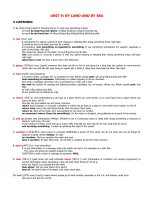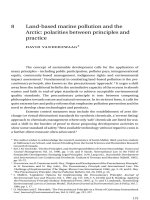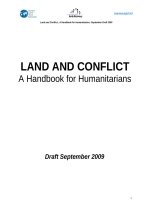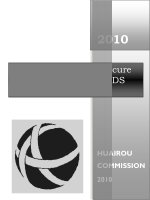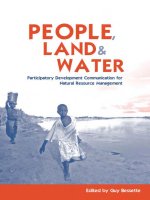Peat land and salt marshes
Bạn đang xem bản rút gọn của tài liệu. Xem và tải ngay bản đầy đủ của tài liệu tại đây (176.05 KB, 7 trang )
Describe and compare peat land and salt
marshes in the world
I. Introduction
Wetlands are important and valued environments for many reasons.
They are highly productive ecosystems, and are able to capture energy and provide
food for many animals and provide important refuges for wildlife in times of
drought. Wetlands provide a natural water balance in the landscape and help to
provide protection against floods and have a role in providing water quality
protection in the catchment by filtering pollutants such as sediments, nutrients,
organic and inorganic matter and bacteria.
Benefit living things, wetlands support a wide variety of flora (plants) and fauna
(animals) and form different habitats and ecosystems. They provide nursery areas
for fish, and breeding grounds for wildlife, particularly water birds. Wetlands
provide vital habitat for some species of threatened fauna (animals) and provide
refuge for migratory water birds that breed in the northern hemisphere in countries
such as China and Siberia. Thousands of migratory water birds inhabit Australian
wetlands each year.
Many wetlands are of cultural significance to aboriginal people. They are naturally
beautiful places and provide opportunities for recreation activities such as boating,
swimming, bushwalking and bird watching and they provide opportunities for
scientific research and are a source of education for the community.
Peatlands and salt marshes are two popular and important kinds of wetland. There
are so many research and study in order to effectively use and conserve them.
II. Study Methodology
III. Results and discussion Analysis
& synthesis document
Basing on the practical requirements of the environmental survey, analysis &
synthesis research materials to help realize the necessity of innovation in how to
conduct preparatory work. Since then, based on the contents of the previous studies
and articles, we synthesis important knowledge to finish our report.
1. Peatlands
Peatland is the term given to an area in which peat has accumulated. If peat
continues to develop and accumulate, the area is called live peatland or peat bog. If
the peatland has been covered by mud or sand, the deposit is known as buried peat.
If the peatland has been drained, so that development of peat has ceased, the
peatland is called dead peatland. So there are two kinds of peatland: live peatland
(peat bog) and dead peatland (drained or buried peatland).
Peatlands are widely distributed across the globe, occurring in at least 175
countries, covering approximately 3% (4 million km2) of the world’s land area. Of
these 175 countries, the UK ranks within the top ten in terms of its total peatland
area (46,000 – 77,000km2, 19 – 32% of UK land area). The UK’s relatively large
area of peatland also includes 13% of the world’s blanket bog, one of the rarest
habitats on earth (IUCN Commission of Inquiry on Peatlands, 2011).
Peatlands are not only of international importance because of their unique
biodiversity. They also have a major role in global carbon cycles, national
hydrology (70% of UK’s drinking water flows from peat dominated uplands),
natural risk regulation (i.e. fire and floods) and recreation, as well as providing
other ecosystem services, all of which influence human health and well-being.
a) Living things
Animals
The wet conditions characteristic of peatlands are unfavourable for certain
animal groups, but provide ideal conditions for others, especially those with
an aquatic phase in their life cycle. The limited range of bog plants limits the
diversity of plant-eating animals (herbivores), while the lack of nutrients
such as calcium can limit the amount of vertebrates and shelled molluscs. In
general, the presence of many vertebrates on peatlands is often opportunistic
or temporary. Invertebrates such as beetles, moths and dragonflies are better
adapted to the conditions and many are resident throughout the year. All
peatland animals are linked by food chains and food webs.
Plants
The environmental conditions in peatlands can limit the growth and survival
of many plant species. Fens and bogs are wet habitats with limited oxygen
available for plant growth. Bog plants also have to deal with acidic soil and
the lack of essential nutrients including nitrogen, phosphorus, and
potassium. The plants that are found growing on peatlands have developed a
variety of adaptations that allow them to survive in these harsh conditions.
There is little direct competition between peatland plants because different
species have developed different adaptations for survival e.g the roots of the
Heather plant form an association with fungi in order to obtain essential
nutrients while sundews eat insects to obtain these nutrients.
There is considerable variation in the environmental conditions, such as
temperature and moisture, found within a single peatland site. Different parts
of a site can therefore have quite different communities of plants e.g. some
species of Sphagnum moss are only found within pools while others have
adapted to life on the drier hummocks. Although some plant species are
confined to peatlands it is often the communities of plants that are unique.
b) Formed in two ways:
Terrstraialization: succession from pond to forest
Paludification: peat grow out onto adjacent terrestrial land
c) Classification:
Minerotrophic: water and nutrients mainly from groundwater
Ombrotrophic: water and nutrients mainly from precipitation
2. Salt marshes
A salt marsh, also known as a coastal salt marsh or a tidal marsh, is a coastal
ecosystem in the upper coastal intertidal zone between land and open salt water or
brackish water that is regularly flooded by the tides. It is dominated by dense
stands of salt-tolerant plants such as herbs, grasses, or low shrubs. These plants are
terrestrial in origin and are essential to the stability of the salt marsh in trapping
and binding sediments. Salt marshes play a large role in the aquatic food web and
the delivery of nutrients to coastal waters. They also support terrestrial animals and
provide coastal protection.
Salt marshes are important transitional habitat between the ocean and the land;
they are estuaries where fresh and salt water mix. Salt marsh plants (halophytes)
are salt tolerant and adapted to water levels that fluctuate with the tide. Tides carry
in nutrients that stimulate plant growth in the marsh and carry out organic material
that feeds fish and other coastal organisms. Over time, salt marshes accumulate
organic material, forming into a dense layer called peat. Salt marshes are among
the most productive ecosystems on earth, rivaling that of an Iowa cornfield. The
position of salt marshes on the landscape and their productivity makes them
important not only as a part of the natural world but also to humans. There are
about 6,200 acres of salt marsh in New Hampshire, many of which have been
damaged by management actions that have had unintentional consequences:
restricted tidal flow, filling, ditching, and increased freshwater flows. Due to
degradation, restoration is often necessary to improve the following functions that
salt marshes provide.
a) Living things
Plants:
Salt marshes are home to many cosmospolitan genera, including Spartina,
Juncus, Salicornia and Limonium. However, species are distributed in zones
within the Marsh. Zoneation is controlles by elevation within the marsh and
physicochemical properties such as Eh-O2, salinity and nutrient availability.
Fauna:
Invertibrates are adapted to flooding and dessication( behavioral,
respiratory-blood pigments such as haemoglobin, chlorocruorin in
polychaetes) and salinity.
Most osmoconformers are sedentary( Mytilus, Arenicola) whereas
osmoregulators tend to be motile. Os
Invertebrates are distributed distributed across the marsh in zones, much,
like plants. These zones form as the result of environmental gradients of
tidal incursion, dessication and salinity.
Vertebrates include finfish and birds( waterfowl, wading birds, shorebirds).
These organisms are highly motile and migrate in and out of the marsh.
b) Formation:
March formation requires relatively flat topography required in a low wave
energy environment to enable establishment of emergent vegetation.
Sediment deposition is important in raising the marsh surface elevation
above MHWN. This scenario assumes a constant sea level and does not
account for tectonic uplift, subsidence or rising sea level.
Vegetable is essential for trapping sediments and for stabilizing shorelines.
Mature S. alterniflora dampens wave height by 71% and wave energy by
92%.
Thus, as sea level rises, marshes are able to continually grow upward via
sediment deposition and in situ organic matter accumulation.
IV. Conclusion
Peat lands and salt marshes are two of the most important ecosystems on the
planet. These marshes serve as a buffer against the elements of the shoreline, a
natural filtering system, and a safe haven for different organisms.
Many studies have proven that various chemical effects and physical efforts affect
the survival rate of the salt marshes and peat lands such as salinity and
restoration. Salt marshes and peat lands have been faced with a lot of destruction,
which is mainly anthropogenic. Human activity has directly and indirectly affected
the marshes through grazing, dredging, development, salt-water intrusion, and the
dumping of chemicals into water systems.
In order to protect these valuable kinds of wetland, education, legislative action,
and further research needs to take place more in future.
V. Reference
Peatlands and Climate Change, Maria strack
www.noticenature.ie
Realising the Benefits of Peatlands, RSPB Scotland

